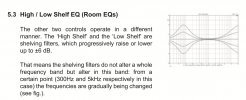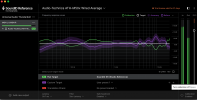Jim DeSchamp
Inspired
So after reading this I just shelled out $$$ for a pair of Focal Solo 6 BE's!
I'm still in shock
I'm still in shock
Why? Like them?I'm still in shock
Thank you!Jin beat me to it, and I agree with his answers.
I think this is one of the worst threads that drives people to invest more money.So after reading this I just shelled out $$$ for a pair of Focal Solo 6 BE's!
I'm still in shock
You can't.Thank you!
Luckily sonarworks has a trial period. What I want to understand when I'll try it is if the result I achieve with sonarwork equalization I can also achieve with the "room controls" on the back of the studio monitors. I mean, once I know what is the target, maybe I can approssimate that result.
I don't have them yet it was more of the sticker shockerWhy? Like them?
So they are totally useless? Better to keep them flat?You can't.
The controls on the back of monitors are super-generalized. Some of them are for "taste", some of them compensate for how the speaker is loaded (by the space). They don't do anything really like room correction.
That being said, you have to re-do the calibration when you change those settings.

So they are totally useless? Better to keep them flat?
View attachment 95387
You're better off using the peq in global eq of axe fx for output block1 /2 or whatever you are using. Check the setup page if you want to approximate the correction yourself, but you wont get really accurate.Luckily sonarworks has a trial period. What I want to understand, when I'll try it, is if the result I achieve with sonarwork equalization I can also achieve with the "room controls" on the back of the studio monitors
Not necessarily. They do different things.So they are totally useless? Better to keep them flat?
View attachment 95387
Or just do the whole damn wall.

Should not be worse, which version do you have, Both SW and ARC do the same thing more or less. You have more mic options with the arc and they make many different measurement mics.How much worse is IK's ARC than Sonarworks?
I've had ARC for years, bought on sale, but I've never done it completely right.
These headphones are not pretty colored themselves as well apart from the higher end after 10k which is not really noticeable to alot of people. it will only correct what needs to be corrected. so if you use headphones that more or less arent colored it will not apply as much correction either.Just tried with my headphones, Audio Technica ATH-M50X.
View attachment 95398
Honestly the difference is practically impossible to hear, with multiple genres of music or with guitar no difference honestly. Even the curves are not that far away from the flat one...I hope that with the monitors it will be more evident or I think I will return everything.
So the standalone without a daw and the axe in the analog in of the interface won’t get any correction?as the standalone app doesnt pick any audio from the guitar but only the system
Yes I did that. This weekend I’ll try with the studio monitor. For my headphones is useless.Also ensure you're choosing the sound id output
YEP you need to create a monitoring channel in the daw, turn input monitoring on and mute the axe analog out put audio, other than the usb one. to not hear double sound, as your guitar signal can be fed into the computer only via usb.So the standalone without a daw and the axe in the analog in of the interface won’t get any correction?
I would need it more for playing than for recording.
This is a great idea that I will explore for sure. Thanks a lot for all of the info you are sharing.To offset this very issue i make irs of the correction curve with and add it to axe , so then i never need to use daw unless i am recording.
How much worse is IK's ARC than Sonarworks?
I've had ARC for years, bought on sale, but I've never done it completely right.
Or just do the whole damn wall.
